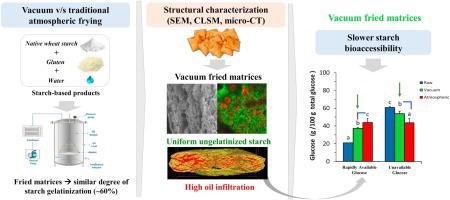Food Structure ( IF 5.6 ) Pub Date : 2020-06-30 , DOI: 10.1016/j.foostr.2020.100146 Ingrid Contardo , Bryony James , Pedro Bouchon

|
During vacuum frying, starch gelatinization may be limited due to the water boiling point depression, which reduces starch digestibility. In addition, relevant structural changes are induced, which could affect the accessibility of amylolytic enzymes to the site of action. To differentiate the effect of structural changes in the food matrix over the effect of starch gelatinization on starch digestibility, we characterized the microstructure using x-ray micro-computed tomography (micro-CT), confocal laser scanning microscopy (CLSM) and environmental scanning electron microscopy (ESEM), and we also studied the starch in vitro digestibility in two different systems: vacuum (9.9 kPa, Twater-boiling-point = 45 °C) and traditional atmospherically-fried dough (170 °C) with a similar degree of starch gelatinization (60 %). Vacuum-fried matrices had a much higher oil content (∼51.3 % dry basis) than their atmospheric counterparts (∼20.3 % dry basis), as confirmed through micro-CT and CLSM.
The quantitative analysis of micro-CT images showed that vacuum-fried samples had less air porosity (36.6 % air-filled pores) than atmospheric fried ones (49 % air-filled pores), whereas, no differences were found with respect to total porosity (p < 0.05). Vacuum-fried samples exhibited significantly lower rapid available glucose levels (38 %) and higher unavailable glucose levels (52 %), compared to those found in atmospheric-fried samples (43 and 43 %, respectively). Since all matrices contained a similar starch gelatinization degree, this difference may be attributed to the high oil content within the matrix, linked to a homogenous arrangement of ungelatinized starch throughout the inner matrix and the presence of external cracks on the surface, resulting in a weaker structure.
中文翻译:

真空油炸基质的微观结构表征及其对淀粉消化的影响
在真空油炸期间,由于水沸点降低,淀粉糊化可能受到限制,从而降低了淀粉的消化率。另外,引起相关的结构变化,这可能影响淀粉分解酶对作用位点的可及性。为了区分淀粉糊化对淀粉消化率的影响,食物基质中结构变化的影响,我们使用X射线微计算机断层扫描(micro-CT),共聚焦激光扫描显微镜(CLSM)和环境扫描电子对微结构进行了表征显微镜(ESEM),我们还研究了淀粉在两种不同系统中的体外消化率:真空(9.9 kPa,T水沸点 = 45°C)和传统的常压面团(170°C),淀粉糊化程度相似(60%)。通过micro-CT和CLSM证实,真空油炸基质的油含量(干基约为51.3%)比常压基质(干基约为20.3%)高得多。
显微CT图像的定量分析表明,真空油炸样品的空气孔隙率(36.6%的充气孔)比大气油炸样品(49%的充气孔)少,而总孔隙率没有差异(p <0.05)。与在大气中油炸的样品(分别为43%和43%)相比,真空油炸的样品显示出明显较低的快速有效葡萄糖水平(38%)和较高的不可用葡萄糖水平(52%)。由于所有基质都具有相似的淀粉糊化度,这种差异可能归因于基质中的高油含量,这与整个内部基质中未糊化淀粉的均匀排列以及表面上存在外部裂缝有关,从而导致较弱结构体。











































 京公网安备 11010802027423号
京公网安备 11010802027423号